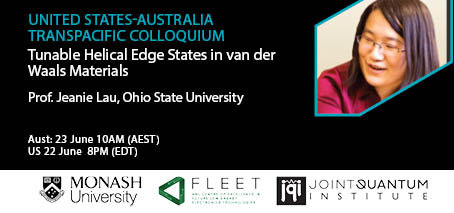-
23 Jun 2021
10:00 am - 11:00 am
Professor Jeanie Lau, Ohio State University
23 June, 10am (AEST)
Missed the event? Catch up here on YouTube
Helical conductors, systems that have no bulk conduction but support dissipationless conducting states at their edges, may be engineered to realize Majorana statistics for quantum computation. Underlying these remarkable systems are the non-trivial topology of electronic structure in the bulk, arising band inversion in the bulk and crossing of conductance and valence bands at the system boundary. Here we show that helical edge states are achievable and tunable in few-layer van der Waals materials. In Bernal-stacked trilayer and tetralayer graphene, we observe helical edge states at moderate and strong magnetic fields, respectively, arising from the competing effects of inter-layer coherence, electrostatic polarization and exchange interaction. As the interlayer potential and magnetic field varies, we observe a series of quantum transitions among the phases that host 2, 1 and 0 helical edge states on each edge. Our work highlights the complex competing symmetries in few-layer graphene and the rich quantum phases in this seemingly simple system. Lastly, in thin exfoliated Bi4I4 samples, which is a quasi-1D topological insulator and candidate for higher order topological states, we observe gate-tunable magneto-transport and Josephson current. Our combined transport, photoemission, and theoretical results indicate that the gate-tunable channels consist of novel gapped side surface states, a 2D TI in the bottommost layer, and helical hinge states of the upper layers.
Prof. Lau is head of the Quantum Research Lab in the Department of Physics, Ohio State University
This talk is part of an ongoing series of talks by US and Australian researchers presenting novel developments in condensed matter and cold atomic physics, enriching connections between the two physics communities. Co-presented by FLEET, Monash School of Physics and Astronomy, and the Joint Quantum Institute.

